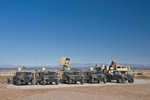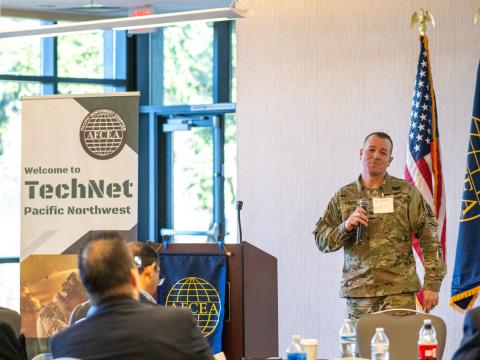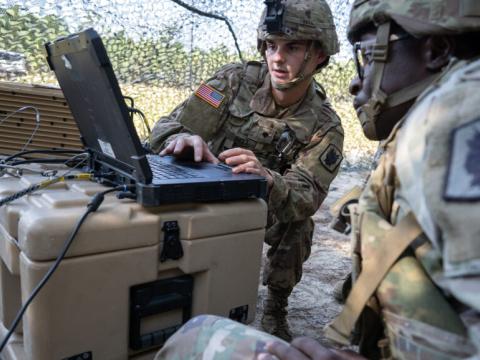Warfighter Network Takes Shape
 |
| Parts of the U.S. Army’s Warfighter Information Network-Tactical (WIN-T) are beginning to deploy to forces in Southwest Asia. WIN-T will connect all echelons with a seamless, high-bandwidth network for voice, video and data communications. A key part of the program is vehicle-mounted mobile satellite communications terminals. These vehicles participated in a WIN-T operational test at Fort Huachuca, Arizona. The terminals will allow units to be connected while on the move across rough terrain. |
The initial stages of the U.S. Army’s new tactical communications architecture are now operational. When it is complete, the network will connect units across all echelons with high-bandwidth voice, video and data streams. Many of the major components of this architecture are beginning to be fielded to units, providing forces with enhanced operational awareness and increased connectivity as the entire system goes online in coming years.
A key part of the Army’s modernization efforts, the Warfighter Information Network-Tactical (WIN-T) is now connecting command posts across
WIN-T Increment 1 evolved out of the Joint Network Node (JNN) program and has two segments, Increments 1-a and 1-b. Increment 1-a is the competitive contract for the former JNN program and includes military Ka-band capabilities. These units are now being fielded, notes Col. William C. Hoppe,
Increment 1 also is refitting all legacy equipment that spiraled out before the JNN became part of the WIN-T program. As these units rotate back to the
Increment 1 consists of three types of equipment: basic networking and routing hardware housed in vehicle shelters and transit cases; satellite communications terminals such as the JNN; and line-of-sight radios. However, the JNN and Increment 1-supported command posts in Southwest Asia are so widely dispersed that satellite communications instead of line-of-sight radio links form the primary communications links, says Bill Weiss, vice president of tactical networks for General Dynamics’ Command, Control, Communications and Computers (C4) division,
The remaining components for Increment 1 consist of network management software tools for configuration and troubleshooting. These systems are largely ruggedized commercial products, Weiss says. Increment 1 is optimized for networking at the halt and static command posts.
Increment 1-b features two technologies found in Increment 2: the network-centric waveform (NCW) and colorless core cryptography. The NCW allows the system to provide one-hop compatibility and is installed in the mobile satellite trailer units’ modems. The colonel explains that this capability allows Increment 2 units to communicate directly to Increment 1-b units without intermediate steps.
Colorless core cryptography is a high-assurance, National Security Agency-approved Internet protocol encryptor that allows Increment 2’s security architecture to cover Increment 1-b systems. Col. Hoppe explains that these technologies will be installed into the satellite communications trailers equipped with Increment 1-a systems to allow them to communicate directly—in one hop—to Increment 2 units.
Increment 2 will continue to rely extensively on commercial networking products, but it will include three key technologies: waveforms, antennas and network automation tools. These waveforms are optimized for high-capacity broadband networking and support to mobile ad hoc, self-forming networks. “Part of the job of making sure that this network stays glued together is implemented within the radio and satellite communications themselves to make them efficient. When a link is established, you won’t need a signal soldier worrying about every detail of configuring a link because the radio links figure out how to configure themselves,” Weiss says.
 |
| WIN-T capabilities such as networking waveforms and high-data-rate radios are beginning to be fielded to the troops. When the system is fully distributed, it will connect other Army systems that rely on high-bandwidth waveforms such as the Joint Tactical Radio System and the Future Combat Systems. |
Most of the network support and automation tools for Increment 1 are commercial products. For Increments 2 and 3, the program is developing automated capabilities to manage mobile communications from command posts out to moving vehicles. The automation will be embedded in the Army’s different vehicle platforms to manage networking on the move automatically. “It’s all about keeping highly mobile forces glued together,” Weiss maintains.
WIN-T Increment 3 also will include two classes of unmanned aerial vehicles (UAVs): a robot helicopter and a more conventional airborne platform, the Sky Warrior extended-range multipurpose UAV. One feature of both of these aircraft is that they also will serve as airborne nodes. Weiss notes that an airborne node has many of the advantages of a satellite without the delays of launching an orbital platform. However, he adds that the Army currently is establishing the required doctrine to use UAVs as communications nodes. He notes that until recently, the operational priorities for unmanned aerial platforms focused on their roles as reconnaissance and attack platforms.
Increment 1-b’s delivery schedule is directly tied to Increment 2. Army units at
The colonel observes that this was the largest user test for WIN-T. The event involved the 3rd Infantry Division, headquartered at
A communications hub at
Increment 2 will be entering low-rate production within the next 12 months, with production qualification testing beginning in the first quarter of 2011. Units will begin receiving the new equipment in fiscal year 2011. Increment 1-b will roll out at the same time, because it is linked to Increment 2, Col. Hoppe asserts. A decision review is pending regarding baseline Increment 3. The review will take place this month. Increment 3 moves to a critical design review for the first quarter of 2010.
Several WIN-T technologies are now being issued to warfighters. One example is military Ka-band communications, which became available with Increment 1-a. “Spectrum is a finite asset. The more people push stuff up over satellite, the more crowded the spectrum gets, and the more important it is for us to have multiple-band-capable systems,” he says.
Currently, Increment 1 equipment operates strictly on the commercial Ku band. With the launch of the Wideband Gapfiller Satellite (WGS) and the pending launch of WGS 2, the Army will be able to use the military Ka spectrum. However, Col. Hoppe cautions that the satellite probably will not be ready for full operation until this fall. The WGS 2 satellite will be placed over the U.S. Central Command area of responsibility, where the colonel believes that it will have an immediate impact on warfighters in the area.
Two other WIN-T waveforms are now helping warfighters: the NCW and the High Band Networking Waveform (HBNW). The NCW has been operational in theater for more than 18 months. Although he cannot provide details, Col. Hoppe says that the waveform has performed very well for on-the-move communications. The waveform has been so successful that a demand exists to surge additional capabilities into the region, he adds.
While the NCW allows WIN-T-equipped units to conduct mobile ad hoc networking via satellite connections, the HBNW is a line-of-sight waveform for mobile, ad hoc networking on the ground. These capabilities will be linked in Increments 2 and 3, but the colonel notes that a handful of radios in
A commercial technology used across all of the WIN-T increments is a wide area network (WAN) accelerator appliance. Consisting of a modem and commercial software, the system allows satellite links to operate more efficiently. Known as WANScaler, the application mitigates the delays inherent in transmission control protocol/Internet protocol (TCPIP) transmissions across satellite links.
Tom Simmons, area vice president, Citrix Government Systems,
Simmons notes that Army units using WANScaler are often in combat situations where they require uninterrupted access to live data applications. The configuration that prime contractor General Dynamics offers is optimized to operate on the U.S. Defense Department’s network and includes the space communications protocol.
Besides the individual increments, the program also is using IEEE 802.16 waveforms and multichannel satellite terminals. Col. Hoppe explains that many of these terminals operate in the Ku band and soon will be upgraded to the Ka band. The program also is working on spectrum management applications.
The colonel notes that the main reason for Increments 2 and 3 is to provide the planning and networking capability for on-the-move communications. He says that this is a different tool set from what current applications provide. Noting that the capability is very mature, he adds that the ability to plan and push policies for on-the-move communications is available today.
The development of mobile communications is changing the way planners think about communications planning, Col. Hoppe says. For example, an entire generation of signals soldiers used “victor one and victor three” technology—setting up three line-of-sight antennas and three radios. WIN-T’s high-band networking radio (HNR) uses a directional antenna to locate its peers, and it can link itself without the need to set up line-of-sight links. He notes that the front of the HNR radio has one switch and seven lights, making it very easy for soldiers to operate with little or no training.
Web Resources
Project Manager Warfighter Information Network-Tactical: http://peoc3t.monmouth.army.mil/win_t/win_t.html
General Dynamics C4 Systems: www.gdc4s.com
Citrix: www.citrix.com




Comments